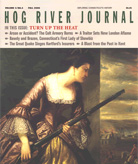(c) Connecticut Explored Inc. Fall 2006
Subscribe/Buy the Issue!
After wandering through the bucolic Connecticut landscape in our summer issue, we “Turn Up the Heat” for fall by examining the ways in which fire, passion, and the pursuit of warmth have left their marks on our state. The 225th anniversary of the burning of New London by Benedict Arnold’s forces in the Revolutionary War inspired our theme, and Edward Baker’s account of this event (page 20) reminds us of the strategic role New London played in the war and the fire’s lasting effects on the city. One example is that, to the continued frustration of historians, genealogists, and others who rely on records from the past, large chunks of documentation were lost when flames consumed the court house and other repositories.
The theme of fire’s destructive potential holds personal resonance for me. When I completed my duties as interim director of Hill-Stead Museum in Farmington, a post l’d held for 15 months in 1996-97, I experienced a surprising sense of relief. It was as though a heavy weight had rolled off my shoulders. At first I couldn’t figure out why I felt as I did. I’d thoroughly enjoyed my time leading Hill-Stead, a wonderful 1901 house on 152 beautiful acres with an incredible French Impressionist art collection. It had been a privilege to serve the museum, and I’d fallen in love with the place. I eventually realized I felt relieved because this National Historic Landmark was still intact. It hadn’t burned down on my watch! I hadn’t been conscious of the weight of that responsibility until it was no longer mine.
My worry about fire turned out not to be unreasonable. The November/December 2002 issue of
Preservation magazine featured a cover story by Jean Dunbar that discussed the very real and constant threat of fire to historic structures and collections. It noted that fires damage or destroy 2,000 historic sites in the U.S. each year. Danny McDaniel, head of Colonial Williamsburg’s security and a former chair of the National Fire Protection Association’s cultural resources committee, was quoted as saying, “The question is not will an old building catch fire, but when.” Museum staff and boards of directors are called both to be vigilant and to have in place the best and most high-tech security and fire protection systems they can afford.
Because of my experience at Hill-Stead, I give great credit to those in the museum field who are daily carrying this responsibility. But fire is not always hostile, and in this issue we also look at ways we’ve harnessed fire, been inspired by the fires in our own bellies, and created objects of great beauty that also served to keep us warm on cold Connecticut nights.
We hope this issue further sparks your interest in Connecticut’s history and leaves you with a burning desire to know more!
Explore!
Read all of the stories in the Fall 2006 issue
Read all of our stories about Historic Preservation on our TOPICS page

